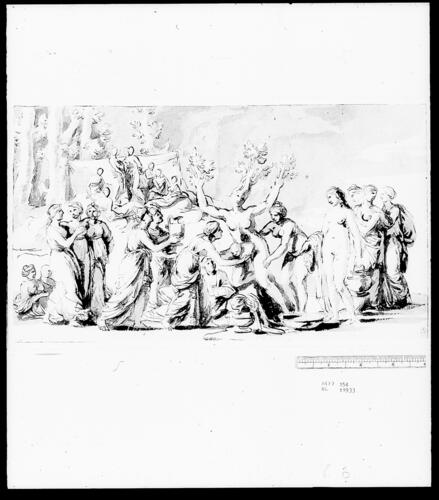-
1 of 253523 objects
The Birth of Adonis c.1622-23
Pen and brown ink, grey wash | 18.3 x 32.5 cm (sheet of paper) | RCIN 911933
-
A drawing made by Poussin for the poet Giovanni Battista Marino in Paris, c.1622-23. The beautiful youth Adonis was born of the incest between Myrrha and her father, King Cinyras. Aided by her maid, Myrrha tricked her way into Cinyras's bed; when he discovered the deceit, he chased her from the palace and she roamed the countryside imploring the gods to end her misery. Taking pity on her, they changed her into the myrrh tree, whereupon her bark split open and the child Adonis was born.
The episode was described in detail by Ovid (Metamorphoses, X, 476ff; despite the title, Marino's long poem Adone is about much more than the life of Adonis, and he treated the birth only in passing), and this was the source for most artists' treatment of the subject throughout the sixteenth and seventeenth centuries. Naiads receive the child, and other nymphs hold a vessel to catch the tears of Myrrha - the resin of the tree from which myrrh is obtained. The standard elements would have been known to Poussin from an engraving in one of the many illustrated editions of Ovid, such as that published in Paris in 1619.
According to Poussin’s early biographer Giovanni Pietro Bellori, as a young man Poussin lodged with the poet Giovanni Battista Marino in Paris c.1622-23, before Marino returned to Italy in April/May 1623. While Marino was housebound through illness he passed the time by watching Poussin make drawings after themes from his poetry. Bellori describes in detail one of the drawings made by Poussin at this time, the Birth of Adonis, which he had later seen in the collection of Cardinal Massimi (G.B. Bellori, Le Vite de Pittori, Scultori et Architetti Moderni, Rome 1672, pp. 410ff). This can be identified with RCIN 911933, and as the style, dimensions and technique of 911933-47 are more or less uniform (though 911945-6 are vertical in format), we may infer that the whole series was drawn for Marino. To these fifteen may be added a drawing in Budapest (inv. 2880; Rosenberg & Prat 1994, no. 18; the subject is unclear), which is stylistically identical to the Windsor group and in the same format.
Bellori took the Birth of Adonis to be an illustration of Marino's long poem Adone, published in 1623, and assumed that all the drawings were illustrations to this work; G.B. Passeri went one step further to claim that a publication of the Adone was planned with engravings after Poussin's designs. In fact none of the drawings corresponds closely to known passages in Marino's poetry, and although copies of the Windsor sheets are known, we have no evidence that the compositions were worked up into more elaborate drawings, either to serve as finished works of art (perhaps to accompany a manuscript of poems), or as working models for an engraver.
The Marino drawings came to Windsor in a volume assembled by Camillo Massimi; according to a biography of Marino appended to the 1627 edition of his Adone, he left his art collection to friends in Rome on his death in 1625, and the mythological drawings may have found their way into Massimi's hands at a later date. It is possible that Massimi obtained them directly from Poussin himself, perhaps in the late 1630s when he was taking drawing lessons from Poussin, by which time the artist must have felt little affection for these gauche compositions.
The Windsor Marino drawings were rejected as mid-century (and implicitly Roman) copies by Konrad Oberhuber (Poussin: The Early Years in Rome, Fort Worth 1988), a stance that found some support in reviews of the exhibition. But several of the drawings bear Nivelle watermarks that show the paper was produced near Paris by 1621 at the latest (Clayton, Burlington Magazine 1991, p. 245), which must dispel any doubt that the Windsor drawings are originals.
Provenance
Cardinal Camillo Massimi (1620-1677); from whose heirs bought in 1739, for 300 scudi, by Richard Mead (1673-1754); probably presented to Frederick, Prince of Wales, by 1750
-
Creator(s)
Acquirer(s)
-
Medium and techniques
Pen and brown ink, grey wash
Measurements
18.3 x 32.5 cm (sheet of paper)
Object type(s)
Other number(s)
RL 11933Alternative title(s)
Mirra conversa in Albero

